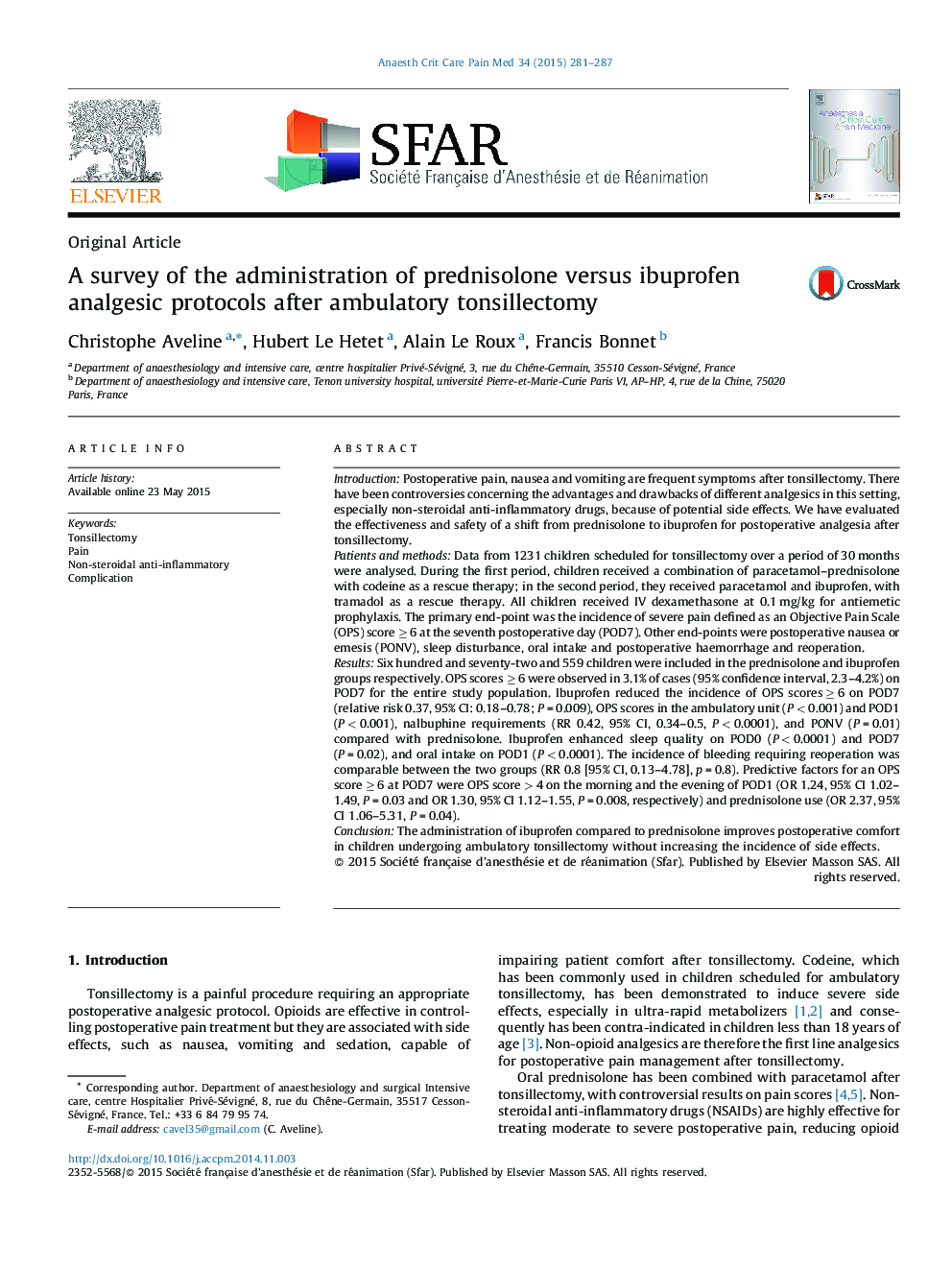| کد مقاله | کد نشریه | سال انتشار | مقاله انگلیسی | نسخه تمام متن |
|---|---|---|---|---|
| 2741910 | 1148569 | 2015 | 7 صفحه PDF | دانلود رایگان |
IntroductionPostoperative pain, nausea and vomiting are frequent symptoms after tonsillectomy. There have been controversies concerning the advantages and drawbacks of different analgesics in this setting, especially non-steroidal anti-inflammatory drugs, because of potential side effects. We have evaluated the effectiveness and safety of a shift from prednisolone to ibuprofen for postoperative analgesia after tonsillectomy.Patients and methodsData from 1231 children scheduled for tonsillectomy over a period of 30 months were analysed. During the first period, children received a combination of paracetamol–prednisolone with codeine as a rescue therapy; in the second period, they received paracetamol and ibuprofen, with tramadol as a rescue therapy. All children received IV dexamethasone at 0.1 mg/kg for antiemetic prophylaxis. The primary end-point was the incidence of severe pain defined as an Objective Pain Scale (OPS) score ≥ 6 at the seventh postoperative day (POD7). Other end-points were postoperative nausea or emesis (PONV), sleep disturbance, oral intake and postoperative haemorrhage and reoperation.ResultsSix hundred and seventy-two and 559 children were included in the prednisolone and ibuprofen groups respectively. OPS scores ≥ 6 were observed in 3.1% of cases (95% confidence interval, 2.3–4.2%) on POD7 for the entire study population. Ibuprofen reduced the incidence of OPS scores ≥ 6 on POD7 (relative risk 0.37, 95% CI: 0.18–0.78; P = 0.009), OPS scores in the ambulatory unit (P < 0.001) and POD1 (P < 0.001), nalbuphine requirements (RR 0.42, 95% CI, 0.34–0.5, P < 0.0001), and PONV (P = 0.01) compared with prednisolone. Ibuprofen enhanced sleep quality on POD0 (P < 0.0001) and POD7 (P = 0.02), and oral intake on POD1 (P < 0.0001). The incidence of bleeding requiring reoperation was comparable between the two groups (RR 0.8 [95% CI, 0.13–4.78], p = 0.8). Predictive factors for an OPS score ≥ 6 at POD7 were OPS score > 4 on the morning and the evening of POD1 (OR 1.24, 95% CI 1.02–1.49, P = 0.03 and OR 1.30, 95% CI 1.12–1.55, P = 0.008, respectively) and prednisolone use (OR 2.37, 95% CI 1.06–5.31, P = 0.04).ConclusionThe administration of ibuprofen compared to prednisolone improves postoperative comfort in children undergoing ambulatory tonsillectomy without increasing the incidence of side effects.
Journal: Anaesthesia Critical Care & Pain Medicine - Volume 34, Issue 5, October 2015, Pages 281–287
